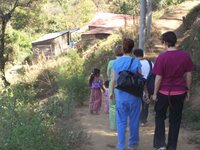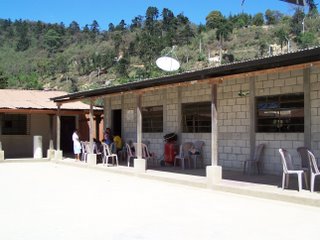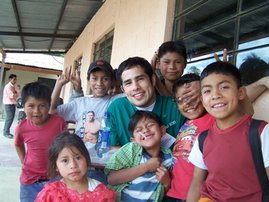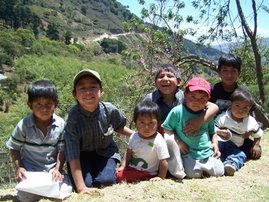Today was the team's second and final day in the little village of El Hato. In an effort to reach more people the project has expanded to do clinics in two villages, as well as a local charity group that has worked closely with the Newberg Noon Rotary in its organization of this trip.
While the majority of the team members climb into two vans and head up the hill, organizers Leroy Benham and Mike Caruso stay in Antigua for a supplies run before joining the others.
This year Leroy has rented a car, a Kia Rio. It's his sixth visit to Antigua -- Mike's fifth -- and both agree that it's getting ever more comfortable to maneuver the city's maze.
"Getting down the the hardware area is getting pretty easy," said Leroy.
The decision to rent a car came as an effort to cut the trip's cost. Like so many projects, the clinics are regularly finding they need something, be it paper towels or Tylenol. In past years the team has simply kept two hired drivers on hand the whole day to manage the errands to town; by simply renting a car, the fee for the drivers, who now simply escort the team to and from the village, is considerably less.
"I believe we can save $400 to $500 by having our own car" for emergencies and errands, Leroy said.
On the way up the rough road Leroy slows for one of many deep ruts.
"Mike," he cued.
"Be careful here," Mike warned, looking out the window.
Up at the school in El Hato, the site of the clinics, the team is busy uncovering the tables of tools and chairs. With the clinics already set up -- tools arranged, chairs standing, water pumping -- the doctors are able to get in and start pulling teeth by ten in the morning.
One of the first dental patients of the day is 5 year old Gustavo. Gustavo needs extractions or fillings for most of his teeth; he came yesterday but panicked after receiving the numbing medication. He returned today, but even the promise of his own soccer ball couldn't keep him from falling apart again once numb. His were the only sobs the clinic saw.
The line for the dental clinic was a long one and children pressed into the cement-block building, watching their comrades and eyeing the goody bags that are handed out to everyone who receives treatment.
The children seem bolder this year than the last. They creep ever closer to the goings-on, occasionally having to be shooed back to keep from getting underfoot. A few of the children boldly ask questions of the team members, such as names and home states, and a few others reach out to touch the skin so much paler than their own; some tease playfully and giggle at the reciprocated attention. A couple can even be coaxed into demonstrating the English they're learning in school.
This boldness suggests a growing trust on the behalf of the villagers, as well as increasing familiarity.
Flor is a member of the Antigua Rotary who has been very instrumental in the success of the team's work in the villages. She helps with screening the patients seeking care and acting as liaison between the Americans and Guatemalans.
"My impression is that a lot of the people who came last year came back," she said of the trust growing among the villagers.
She also noted the appreciation for the medical clinic, which saw an un-ending stream of visitors.
"They feel that there is someone out there for them," she said. She credited much of the medical clinic's success to the presence of the Dr. Jan Paquette, a female doctor; sometimes the women's husbands "won't let them come to see a male doctor."
One of the clinic's many patients today was Jolon, a two and a half year old boy whose had a rash on his cheeks for the past eight days. The boy sat silently on his mother's lap as his mother responds to intake questions posed by Alia Paquette. Dr. Jan interjected occasionally, asking additional questions, and Auggie Gonzales translated.
The rash, Dr. Jan concluded, is simply a result of over-exposure to the sun, possibly residual from a second-degree burn. But during the exam something else was revealed. The boy has a heart murmur.
Heart murmurs result from leaky valves and are not infrequent, nor are they always serious. Many children grow out of them.
"(Jolon's) is a little bit exuberant," Dr. Jan said. In the U.S. they'd run further tests to exclude the possibility of it indication of more serious causes. Here, however, she told Jolon's mother to simply keep an eye on how he does physically. If, as he ages, he seems to have frequent shortness of breath or struggles to keep up with his friends, he should be brought to the city to the specialist.
While Jolon and his mother are typical of the clinic's patients, Alia, who handled intake, added that there were also some men who came by.
"Men actually got off work to come in," she said.
The men typically came in with more specific requests than the women and were less inclined to sit through establishing a medical history. One man, a 75 year old, had broken a rib a few months ago and wanted help so he could continue working.
"I told him to eat chicken cartilage and he looked at me like 'Are you nuts?'" said John Paquette, who as acted as medical assistant. The man then presented a pocket-full of pills he'd been given -- some of which were a form of cartilage, a common treatment for such an ailment -- but didn't what they were.
"We told him how to use those," said Alia, and gave him some Ibuprofen.
Overall the clinic was seeing "stuff we can actually help with," Alia noted, in contrast to yesterday wherein they mostly saw viruses that simply need to run their course.
At the end of the day the team started packing up the equipment in preparation for the move to the next village, Vuelta Grande. After dismantling the chairs equipment stands the team loaded back into a van and down to Antigua.
In the city many of the team members went to a local restaurant for dinner with John Bell and Flor. Both John and Flor work for the local charity Transitions, which largely provides wheelchair's to disabled children, as well as providing medical care. John frequently brings difficult medical cases to Portland, Ore., where they'll receive surgery or treatment at the Oregon Health Science University. John and Flor have also been valuable assets, as well as generous friends, to the whole dental and medical project.
While dinner marked the end of the day for most, a few, in honor of it's being St. Patrick's Day, headed to the local Irish pub, Reilly's. Yes, there really is an Irish pub in Antigua. Happy St. Patrick's Day, and "may your glass be ever full, may the roof over your head always be strong, ad may you reach the gates of heaven half an hour before the devil knows you're dead."
 A line of patients sat at the door but Dr. Jan Paquette focused her attention on 10-year-old Guendi (pronounced "Wendy") who'd returned first thing in the morning for an operation to sever the ligand running the length of her tongue and anchoring it to her lower jaw.
A line of patients sat at the door but Dr. Jan Paquette focused her attention on 10-year-old Guendi (pronounced "Wendy") who'd returned first thing in the morning for an operation to sever the ligand running the length of her tongue and anchoring it to her lower jaw.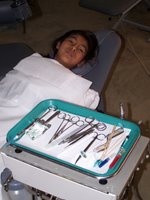 In the makeshift clinic Dr. Jan administered Benadryl to Guendi just before 10 a.m., to make her drowsy. Shortly thereafter it was determined that the dental clinic didn't have the right size suture for the surgery; Leroy Benham and Flor Caniz, a member of the Antigua Rotary who was helping translate for the dental team, jumped in the car and off to Antigua in search of a more appropriate suture.
In the makeshift clinic Dr. Jan administered Benadryl to Guendi just before 10 a.m., to make her drowsy. Shortly thereafter it was determined that the dental clinic didn't have the right size suture for the surgery; Leroy Benham and Flor Caniz, a member of the Antigua Rotary who was helping translate for the dental team, jumped in the car and off to Antigua in search of a more appropriate suture.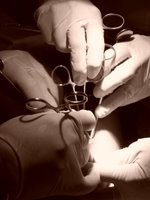
 By the time an hour went by Guendi was already demonstrating increased mobility of her tongue. It will take time, perhaps therapy, for her speech to improve, the doctors noted, but for now things were already looking better.
By the time an hour went by Guendi was already demonstrating increased mobility of her tongue. It will take time, perhaps therapy, for her speech to improve, the doctors noted, but for now things were already looking better.